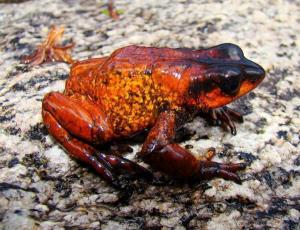Menores Anfíbios do Mundo
 Um dos menores vertebrados anfibios do mundo foi descrito na Índia por SD Biju e seus colegas. Tem hábitos noturnos. A vida deste sapinho está sobre serapilheira e entre as raízes de samambaias da floresta tropical úmida de Western Ghats de Kerala, uma região montanhosa no oeste da Índia. Biju deu um novo nome para o sapo, Nyctibatrachus minimus.
Um dos menores vertebrados anfibios do mundo foi descrito na Índia por SD Biju e seus colegas. Tem hábitos noturnos. A vida deste sapinho está sobre serapilheira e entre as raízes de samambaias da floresta tropical úmida de Western Ghats de Kerala, uma região montanhosa no oeste da Índia. Biju deu um novo nome para o sapo, Nyctibatrachus minimus.Os machos adultos tem apenas 10 mm de comprimento, É um dos sapos em miniatura dentre outras partes do mundo, incluindo Cuba, a Amazônia e Borneo.
A descoberta foi publicada recentemente na revista Science atual. Esta rã minúscula indiano sentado em uma moeda rupia indiana 5 é o menor sapo Índia. (Crédito: Cortesia da imagem da Universidade de Delhi); Este sapo está sentado em uma moeda rupia indiana 5 (Crédito: Cortesia da imagem da Universidade de Delhi)
 Ao lado vemos uma espécie nova de rã amarela que foi encontrada nas montanhas do oeste do Panamá. Pertence a um rico grupo de espécies de anfibios, os rainfrogs, que não possuem uma fase de girino, mas desenvolvem diretamente como pequenos sapos dentro do ovo.
Ao lado vemos uma espécie nova de rã amarela que foi encontrada nas montanhas do oeste do Panamá. Pertence a um rico grupo de espécies de anfibios, os rainfrogs, que não possuem uma fase de girino, mas desenvolvem diretamente como pequenos sapos dentro do ovo.
Vejam Outros Anfibios ...(clicar no link para ver detalhes destes anfibios, Ok )
The Smithsonian's National Zoo maintains an active breeding program for the critically endangered Panamanian golden frog. (Credit: Brian Gratwicke, Smithsonian Conservation Biology Institute) Veja detalhes em: http://www.sciencedaily.com/releases/2011/06/110613174759.htm
An adult La loma tree frog (Hyloscirtus colymba). (Credit: Brian Gratwicke, Smithsonian’s National Zoo) Veja detralhes em: http://www.sciencedaily.com/releases/2010/11/101117141520.htm
The midwife toad: a species that is particularly sensitive to the chytrid fungus. (Credit: Benedikt Schmidt) Veja detalhes em: http://www.sciencedaily.com/releases/2011/06/110620094856.htm
A brightly coloured tropical frog under threat of extinction is the focus of a new research project hoping to better understand how environment and diet influence its development and behaviour. (Credit: Image courtesy of University of Manchester.
Veja detalhes em: http://www.sciencedaily.com/releases/2007/10/071025094918.htm
Red-eyed tree frog. Amphibians like frogs and toads have existed for 360 million years and survived when the dinosaurs didn't, but a new aquatic fungus is threatening to make many of them extinct. (Credit: iStockphoto/Mark Kostich).
Veja detalhes em: http://www.sciencedaily.com/releases/2009/11/091123114640.htm
Limnonectes macrocephalus, one of the frog species in the Philippines that was surveyed by Vance Vredenburg and colleagues for their Asian survey of the chytrid fungus. (Credit: R. Brown, University of Kansas).
Veja detalhes em: http://www.sciencedaily.com/releases/2011/08/110817130945.htm
Red-eyed tree frog. Amphibian populations are declining worldwide, principally because of the spread of the fungal disease chytridiomycosis. Researchers know that some amphibian populations and species are innately more susceptible to the disease than others. (Credit: iStockphoto/Mark Kostich) Veja detalhes em: http://www.sciencedaily.com/releases/2009/04/090401101745.htm
The new frog, which is almost two centimetres in length, was given the name the "golden frog of Supatá." (Credit: Conservation Leadership Programme). Veja detalhes em
Carrikeri harlequin frog. (Credit: Conservation Leadership Programme). After 14 years without having been seen, several young scientists supported by the Conservation Leadership Programme (CLP), have rediscovered the Carrikeri Harlequin Frog (Atelopus carrikeri) in a remote mountainous region in Colombia.
Veja detalhes em http://www.sciencedaily.com/releases/2008/03/080311160514.htm
Ten newfound species of amphibians — including a frog with spiky skin and three varieties of frogs with transparent skin — have been discovered in the mountains of Colombia.
Veja mais detalhes http://www.foxnews.com/story/0,2933,487464,00.html#ixzz1vl94UqYM
Herpetologists from the California Academy of Sciences and University of Texas at El Paso discovered a single specimen of the Bururi long-fingered frog (Cardioglossa cyaneospila) during a research expedition to Burundi in December 2011. (Credit: David Blackburn)
Veja detalhes em http://www.sciencedaily.com/releases/2012/03/120327152850.htm
A rain frog, Pristimantis genus, potentially new to science discovered in the hills of Tacarcuna, Colombia.
Veja detalhes em: http://www.foxnews.com/story/0,2933,487464,00.html#ixzz1vl9WxYyO
Clicar no link-fonte abaixo para ver artigos, trabalhos e outro assuntos diversos da ciência:







































Postar um comentário